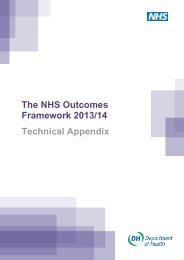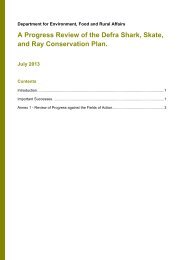Decontamination in primary care dental practices - Gov.uk
Decontamination in primary care dental practices - Gov.uk
Decontamination in primary care dental practices - Gov.uk
You also want an ePaper? Increase the reach of your titles
YUMPU automatically turns print PDFs into web optimized ePapers that Google loves.
<strong>Decontam<strong>in</strong>ation</strong>: Health Technical Memorandum 01-05 – <strong>Decontam<strong>in</strong>ation</strong> <strong>in</strong> <strong>primary</strong> <strong>care</strong> <strong>dental</strong> <strong>practices</strong> (2013 edition)• a basis for record<strong>in</strong>g the ma<strong>in</strong>tenancerequirements;• a basis for record<strong>in</strong>g and access<strong>in</strong>g <strong>in</strong>formationassociated with dis<strong>in</strong>fection and ma<strong>in</strong>tenance.19.31 When complet<strong>in</strong>g records, it is essential that the<strong>in</strong>dividual concerned signs and dates the entries,and that there is an audit trail <strong>in</strong> place.Water supply hygiene19.32 After any <strong>in</strong>stallation work, all pip<strong>in</strong>g, fitt<strong>in</strong>gs andassociated services used for the conveyance ofwater for domestic purposes must be dis<strong>in</strong>fectedbefore be<strong>in</strong>g brought <strong>in</strong>to use. The methodgenerally used for dis<strong>in</strong>fection is chlor<strong>in</strong>ation.Dis<strong>in</strong>fection us<strong>in</strong>g chlor<strong>in</strong>e should be carried out<strong>in</strong> accordance with BS EN 806-2:2005, BS EN806-3:2006 and BS 8558:2011 (see also HealthTechnical Memorandum 04-01 Part A Chapter17) and under the direct supervision of anom<strong>in</strong>ated person.19.33 Despite dis<strong>in</strong>fection of systems, some outbreaks ofdisease related to treated water supplies still occur.To reduce the risk of such outbreaks, the designshould elim<strong>in</strong>ate:• direct contact with the <strong>in</strong>ternal parts of waterpipes and structures by people, animals or birds(for example, ensure covers are <strong>in</strong> place onstorage tanks/cisterns);• backflow (back-siphonage) of contam<strong>in</strong>atedwater <strong>in</strong>to systems convey<strong>in</strong>g potable water(ma<strong>in</strong>s and storage structures).Water treatment19.34 In a properly <strong>in</strong>stalled and commissioned hotwater system, it should be possible to ma<strong>in</strong>ta<strong>in</strong> atemperature of at least 55oC at the furthest drawoffpo<strong>in</strong>t <strong>in</strong> the circulat<strong>in</strong>g system, and 50oC <strong>in</strong>the circulat<strong>in</strong>g system’s return connection to thecalorifier.19.35 In older premises, however, this may not bepossible, and <strong>in</strong> the case of cold water systems itis not always possible or practicable to ma<strong>in</strong>ta<strong>in</strong>water temperature below 20oC because ofutilisation and complexity. In addition, therefore,it may be necessary to apply a residual biocidalwater treatment that has been shown to destroyand remove biofilm. Information on thesetechniques, which <strong>in</strong>clude chlor<strong>in</strong>e dioxide andcopper and silver ionisation, can be found <strong>in</strong>Health Technical Memorandum 04-01 Part B.NoteIn addition to residual biocidal techniques, thereare other manufacturer-specified treatments that aredeveloped for use on DUWLs and other associated<strong>dental</strong> equipment. Refer to the manufacturer’s<strong>in</strong>structions for their correct use.19.36 Where automatic equipment is used fordis<strong>in</strong>fection, it should <strong>in</strong>dicate any change <strong>in</strong> theamount or concentration of material <strong>in</strong>jected <strong>in</strong>tothe water so that immediate action can be taken.19.37 Cont<strong>in</strong>uous dos<strong>in</strong>g with appropriate biocides thathave proven efficacy should be considered dur<strong>in</strong>gconstruction to prevent the accumulation ofbiofilm. A regular flush<strong>in</strong>g programme for alloutlets should also be implemented.19.38 The cont<strong>in</strong>uous chlor<strong>in</strong>ation of hot and cold waterservice systems to control the growth of Legionellais not generally recommended. Advice on the useof biocides should be sought from the personadvis<strong>in</strong>g the practice on Legionella.19.39 In def<strong>in</strong><strong>in</strong>g their responsibilities, service providersshould be asked to advise on test methods andanticipated concentrations of residual chemicalswith<strong>in</strong> the system. (See also Chapter 3 of HealthTechnical Memorandum 04-01 Part A for moreguidance on water treatment regimens.)Purg<strong>in</strong>g the systems19.40 Where chemical treatment is <strong>in</strong>troduced, it isessential to ensure that all parts of the systemare purged so that adequate concentrations areachieved.19.41 As temperature monitor<strong>in</strong>g is performed onsent<strong>in</strong>el and representative outlets on a roll<strong>in</strong>gbasis only, additional draw-off will be required atall po<strong>in</strong>ts on a regular basis.Ozone and ultraviolet treatment19.42 Whereas treatments such as chlor<strong>in</strong>e dioxide andcopper and silver ionisation are <strong>in</strong>tended to bedispersive (that is, they result <strong>in</strong> a residual agentwith<strong>in</strong> the system), ozone and ultraviolet are<strong>in</strong>tended to be effective close to the po<strong>in</strong>t ofapplication. They are not, therefore, necessarilyeffective <strong>in</strong> hot and cold water service systems (seeChapter 15 of Health Technical Memorandum04-01 Part A).70
















